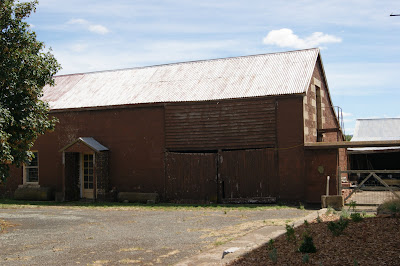Tunbridge
Tunbridge
is a town in the midlands of Tasmania that was originally a coaching stop on the Hobart to Launceston road, now known as the Midlands Highway. It was named after one of its three original coaching inns, the Tunbridge Wells, which in turn was named after Tunbridge Wells in Kent, England.
In its coaching heyday it had three coaching inns, the Tunbridge Wells Inn, the Victoria Inn and the York Inn.. Each inn was associated with a different coaching company. The Tunbridge Wells serviced J. E. Cox Coaches, the Victoria Inn serviced Samuel Page Coaches and the York Inn serviced Alfred Burbury Coaches. Tunbridge Post Office opened on 17 March 1856
Originally known as Tunbridge Wells (after the famous English spa town), Tunbridge is located 92 km from Launceston and 107 km from Hobart. It has been by-passed by the main Midland Highway and consequently has a quiet charm well removed from the urgency of the highway. The town came into existence in 1809 and quickly developed into an important coaching stop between Hobart and Launceston. The area grew rapidly in the 1810s as convicts worked on the road from the north to the south of the island. In recent times the town has been by-passed which has meant that it has been able to maintain much of its historic charm.
Tunbridge Manor is a fantastic piece of Tasmanian history in the centre of town and dominates the townscape. Built in the 1840, as a staging post for the early transport days, where the premises offered accommodation, meals, beverages and stabling for horses.
Up until the late 60's when the highway by-passed the town, it was a magnet for the hungry traveller. For the latter years it has been a private residence. Overall the property is still in good condition. Built over 3 stories, the building has up to 8/10 bedrooms, various bathrooms, large living space, attic rooms, and cellars. Outside there are stables, garages, various sheds, all located on 10 acres bordering the Blackman River.

Built in 1848, the Tunbridge Convict Bridge was constructed by convicts and is the oldest single span bridge in Australia. It spans the Blackman's Riverat the northern end of the town. It is particularly important as it is a rare example of a sandstone bridge with timber decking. The bridge was used as a secret meeting place for a fascinating group of political exiles known as the 'Young Irelanders'. To avoid being seen, they arranged with the local inn to deliver food where they gathered under the bridge. The Young Irelanders roamed far and wide across Tasmania, where Irish sympathisers gave them food and shelter as well as hiding them from the authorities.
Built in 1825, the Tunbridge Wells Inn is a significant example of a single-storey Old Colonial Georgian inn and farmhouse with its long medium-pitched broken-back roof, half-hipped gables, enclosed eaves, flagged veranda and extensive use of local rough-hewn and rubble stone.
The Inn boasts four large bedrooms, two large living areas, two kitchens a dining area, two bathrooms, a large converted loft, sun room and central corridor. The building’s design allows for one large residence or two separate residences both with separate bedrooms, a living area, kitchen and bathroom. The building has five fire places, three in bedrooms, and one in both the main living area and kitchen. There are four doors accessing the house from the front veranda and two from the rear.

The building was strategically erected by Thomas (a former convict) and Ann Flemming, along the original Main Road from Launceston to Hobart. The establishment operated as an Inn until the 1840’s and as a farmhouse after this time. Within the centre of the building, adjoining the main living room, structural... remains of a temporary holding cell for either prisoner’s en route or valuable goods can be seen. Cobble stone remnants of the former Main Road between Hobart and Launceston can be found along the front of the main building today.
The Tunbridge Wells Inn is recognised by the State for its heritage value and was included on the Tasmania Heritage Council Register on 22 September 1999. The building and grounds are recognised by the Historic Cultural Heritage Act 1995 as an important demonstration of the evolution of Tasmanian history and is also considered a significant representative in demonstrating the characteristics of a colonial Inn design.


Other buildings of importance include the Colonial Homestead was built in 1820, the The Victoria Inn (outside is a sandstone roller used to roll the roads by the convicts), the Coaching Stables (1843), The Blind Chapel (now the Masonic Hall and reputedly 'blind' - no windows - on one side so the parishioners didn't have to look at the local pub, and Bowerman's General Store (a handsome two-storey Georgian building with a five bay facade and slim columns)












